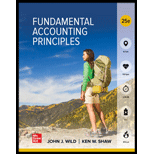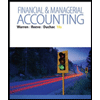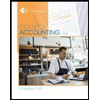
Concept explainers
Applying merchandising terms C1 P1
Enter the letter for each term in the blank space beside the definition that it most closely matches.
A. Sales discount
B. Credit period
C. Discount period
D. FOB destination
E. FOB shipping point
F. Gross profit
G. Merchandise inventory
H. Purchases discount
_1. Goods a company owns and expects to sell to its customers.
_2. Time period that can pass before a customer's full payment is due.
_3. Seller's description of a cash discount granted to buyers in return for early payment.
_4. Ownership of goods is transferred when the seller delivers goods to the carrier.
_5. Purchaser's description of a cash discount received from a supplier of goods.
_6. Difference between net sales and the cost of goods sold.
_7. Time period in which a cash discount is available.
_8. Ownership of goods is transferred when delivered to the buyer's place of business.
A trading business is the business concerned with buying merchandise or goods from manufacturer and selling it to the consumers for certain amount of profit. The difference between the sales and cost directly related to the procurement or production of goods is termed as gross profit. For the common purpose of early payments, seller and suppliers both reduce the price of goods which is called a discount.Free On Board (FOB) is term which specifies the place where the ownership or obligation and risk associated with goods transfers from seller to buyer.
To Match:
Match each term with the closest definition.
Given Info:
| Definitions |
| 1. Goods a company owns and expects to sell to its customers. |
| 2. Time period that can pass before a customer's full payment is due. |
| 3. Seller's description of a cash discount granted to buyers in return for early payment. |
| 4. Ownership of goods is transferred when the seller delivers goods to the carrier. |
| 5. Purchaser's description of a cash discount received from a supplier of goods. |
| 6. Difference between net sales and the cost of goods sold. |
| 7. Time period in which a cash discount is available. |
| 8. Ownership of goods is transferred when delivered to the buyer's place of business. |
| Terms |
| A. Sales discount |
| B. Credit period |
| C. Discount period |
| D. FOB destination |
| E. FOB shipping point |
| F. Gross profit |
| G. Merchandise inventory |
| H. Purchase discount |
Answer to Problem 1QS
| Descriptions | Terms and Phrases |
| Definitions | |
| 1. Goods a company owns and expects to sell to its customers. | G. Merchandise Inventory |
| 2. Time period that can pass before a customer's full payment is due. | B. Credit Period |
| 3. Seller's description of a cash discount granted to buyers in return for early payment. | A. Sales Discount |
| 4. Ownership of goods is transferred when the seller delivers goods to the carrier. | E. FOB Shipping point |
| 5. Purchaser's description of a cash discount received from a supplier of goods. | H. Purchase Discount |
| 6. Difference between net sales and the cost of goods sold. | F. Gross Profit |
| 7. Time period in which a cash discount is available. | C. Discount Period |
| 8. Ownership of goods is transferred when delivered to the buyer's place of business. | D. FOB Destination |
Explanation of Solution
A. Sales Discount: A sales discount basically implies an intentional reduction in the price of a product by the seller as a reward for early payment.
B. Credit Period: It is the duration of time period until which the payment is due. In other words, if the credit period of credit transaction is over, a buyer must pay the full amount for the transaction.
C. Discount Period: A discount period is a time period provided by the seller within which a buyer has right to claim discount on the business transaction.
D. FOB Destination: The term FOB Destination implies that goods have been officially sold to the buyer when the goods reach the buyer's place of business which means ownership of the goods transferred at the delivery point.
E. FOB Shipping Point: FOB shipping point indicates that the obligations, cost or risk concerning the goods will shift from seller to buyer at shipping point of seller. In other words, it means that the buyer is officially responsible for the goods when the seller delivers it to the carrier.
F. Gross Profit: The difference between the direct revenue and direct expense of a business is called gross profit. It computed by deducting the cost of goods sold from net sales during the accounting period.
G. Merchandise Inventory: In a trading business, the goods purchased from manufacturer for the purpose selling it to the consumers is called merchandise inventory.
H. Purchase Discount: A purchase discount is an amount of concession provided by the suppliers to the purchaser with an expectation of early payment and also to attract more purchaser.
Want to see more full solutions like this?
Chapter 5 Solutions
FUND.ACCT.PRIN.
- Peterson Industries reported a net loss of $32,000 during the year. Comparing beginning and ending balances, you determine the following: (1) accounts receivable decreased by $12,000; and (2) accrued expenses payable decreased by $7,000. What was the amount of cash used in operating activities during the year? a. $27,000 b. $37,000 c. $17,000 d. $51,000arrow_forwardWhat is the mark up percentage in full cost to arrive at the target selling pricearrow_forwardPlease help me solve this general accounting problem with the correct financial process.arrow_forward
- Brightway Corporation began using the allowance method in 2020. On January 1, 2020, Brightway had a $5,000 balance in the accounts receivable account and a zero balance in the allowance for doubtful accounts. During 2020, Brightway provided $30,000 of services on account. The company estimated that 4% of ending accounts receivable would be uncollectible. By the end of 2020, customers had paid $26,000 on their accounts. What is the balance in Brightway Corporation's Allowance for Doubtful Accounts at December 31, 2020?arrow_forwardPlease provide the correct answer to this general accounting problem using valid calculations.arrow_forwardFinancial accountingarrow_forward
- How can I solve this financial accounting problem using the appropriate financial process?arrow_forwardWhat is the net income? Please given step by step explanation The general accounting question do fastarrow_forwardThe following amounts were reported by two competing technology companies: Item Digital Solutions Tech Innovators Net Income $125,000 $162,000 Total Assets $850,000 $1,080,000 Total Liabilities $390,000 $520,000 Total Revenues $980,000 $1,350,000 Calculate each company's net profit margin expressed as a percentage.arrow_forward
- Principles of Accounting Volume 1AccountingISBN:9781947172685Author:OpenStaxPublisher:OpenStax College
 Financial & Managerial AccountingAccountingISBN:9781285866307Author:Carl Warren, James M. Reeve, Jonathan DuchacPublisher:Cengage Learning
Financial & Managerial AccountingAccountingISBN:9781285866307Author:Carl Warren, James M. Reeve, Jonathan DuchacPublisher:Cengage Learning College Accounting, Chapters 1-27 (New in Account...AccountingISBN:9781305666160Author:James A. Heintz, Robert W. ParryPublisher:Cengage Learning
College Accounting, Chapters 1-27 (New in Account...AccountingISBN:9781305666160Author:James A. Heintz, Robert W. ParryPublisher:Cengage Learning  Financial Accounting: The Impact on Decision Make...AccountingISBN:9781305654174Author:Gary A. Porter, Curtis L. NortonPublisher:Cengage Learning
Financial Accounting: The Impact on Decision Make...AccountingISBN:9781305654174Author:Gary A. Porter, Curtis L. NortonPublisher:Cengage Learning Accounting (Text Only)AccountingISBN:9781285743615Author:Carl Warren, James M. Reeve, Jonathan DuchacPublisher:Cengage Learning
Accounting (Text Only)AccountingISBN:9781285743615Author:Carl Warren, James M. Reeve, Jonathan DuchacPublisher:Cengage Learning




